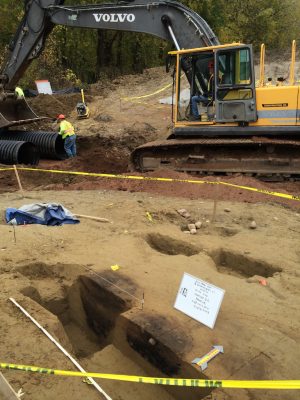Dug Road Site

4500 year old cooking features exposed during construction.
FOSA Newsletter Spring 2015
September already feels like a millennium ago – I guess I’ve been busy! First, let me start off with some of the big-picture items. In the Fall and Spring semesters, FOSA supported an intern, UConn student Melissa Shongut, to help with the organization of the Norris Bull Collection. This semester, the Department of Anthropology also provided research assistantship funding for Zac Singer to work with us as well. For those of you who don’t know it, the Bull Collection is the Office’s core collection of artifacts gathered during the early and mid-twentieth century from across the state by Norris Bull. Acquired in 1960, the need for adequate care of the collection was largely responsible for the hire of Douglas Jordan in 1963. Dr. Jordan was UConn’s first archaeologist and Connecticut’s first de facto State Archaeologist. The Bull collection is a remarkable tribute to Native American craftsmanship across the state. While many of the artifacts are on display at UConn and on loan to other institutions, one day more of this collection must be made available to the public, as it was originally intended by Bull himself. To help OSA further manage this collection, the Department of Anthropology has approved a new internship course in collections management. This course should appear in the catalog next Fall and it is hoped that five or six students will enroll each semester.
In terms of fieldwork, it was a busy time as well. FOSA volunteers helped with a number of Natural Resources Conservation Services projects in towns across the state, including Guilford, Woodstock, and Southbury. FOSA members also provided necessary support for youth excavation programs at the Horton Farm in South Glastonbury and at the very significant Lewis Walpole Site in Farmington, organized by our own Jeremy Pilver. FOSA members also helped Dr. Bellantoni wrap up his investigation of St. Platon’s Church in Danbury. One of the more interesting emergencies I had was a call to a small coffin discovered during waterline work on Farmington Avenue in Hartford. Scott Brady was able to assist in what, luckily, turned out to be a very elaborate dog burial, probably dating back to the eighties. Included inside the padded coffin, lined with white fabric, was a plastic cross, a rosary and two laminated prayer cards. The excavation work was overseen by a representative from the major crimes unit and what appeared to be most of Hartford’s detectives.
That field work was quickly overshadowed by rescue excavation in South Glastonbury, where a large drainage pipe construction inadvertently uncovered a number of Native American cooking hearths and a fire-cracked rock pavement – possibly a portion of a house floor. FOSA members Scott Brady, Lee West, Jerry Cavanaugh, Mike Grant, Brian Meyer, Ed Goodrich, and Glenda Rose volunteered numerous hours at the site. The deep cooking features (or “earth ovens”) were rich in charcoal, but lacked associated artifacts. The fire-cracked rock pavement produced a number of Late Archaic Narrow-Stem points as well as an uncommon paint pot still stained with ocher. One of the cooking features was recently dated to 4230+/-30 radiocarbon years ago, or about 4,800 actual (calibrated) years ago. Negotiations between OSA, the State Historic Preservation Office and the Town of Glastonbury resulted in an agreement to fund the analysis of the site, as well as additional testing closer to Tryon Street. FOSA member Mike Raber was later awarded the contract to do this work. His work includes a budget for additional radiocarbon dating and identification of plant remains from the features. I expect that the rich charcoal samples will provide a better picture of the types of local plants used in the diet by these early inhabitants of Glastonbury.
To wrap up the season, Dr. Douglas Owsley of the Smithsonian spent two full days on campus evaluating human skeletal remains from the William S. Laughlin collection. During his visit, he was helped by UConn students and members of FOSA. Dr. Laughlin was a physical anthropologist at UConn between 1969 and 1999. The materials were brought to OSA by family members so that they could be appropriately repatriated. That work is ongoing.